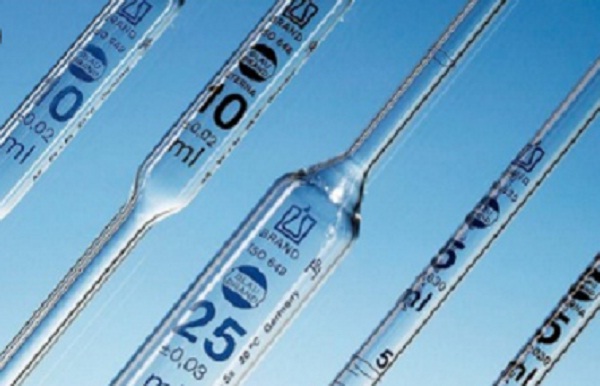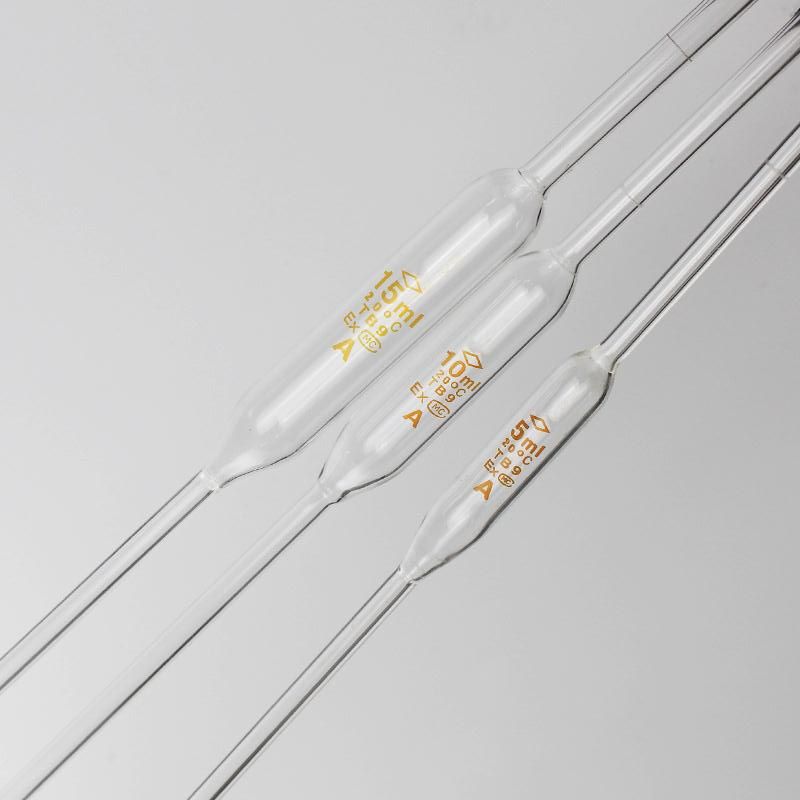A specific type of pipette is called a volumetric pipette for the most accurate and precise measurement of liquids in a laboratory. A pipette is nothing more than a cylinder of transparent borosilicate glass, which is an easy-to-clean element, chemically an inert material and undergoing a small deformation. Look here Volumetric Pipette Use.
In a few cases, the volumetric pipette can also be made of plastic. It has a conical shape at its lower end and is marked with different types of graduations with which the volumes of liquids it contains are measured.
🌡 Volumetric pipette Use
The well-known belly pipettes are used daily in the different volumetric analyses, when there is a need to take into account the exact volume of a smaller sample or reagent solution. As for the tube at the top of the volumetric pipette has so-called annular mark indicating its calibrated volume.
The Pipettes calibrated to deliver (TD or Ex) the indicated volume. When we try to suck with the mouth, the tip of the liquid reaches up to the top, just a little from the mark. The pipette opening should be closed with an index finger.
As for the outer wall of the pipette should be cleaned, then with a subtle loosening of the index finger, the liquid will be released until the mark arrives. Such a demarcation should appear a well-known tangent right at the lower edge of the liquid meniscus. A pipette is discharged by removing the index finger and allowing the liquid to circulate outside the pipette independently.
After another 15 seconds, the tip of the pipette is placed on the inner wall of the container. It should be borne in mind that you should not for any reason blow out the contents of the pipette.
🧪 What is a volumetric pipette?


The volumetric pipette is also known as a volumetric pipette. It is made to measure a certain volume. It is made of plastic or glass material, transfers exact and known volumes of solutions. They have engraved marks on the glass that indicate different volume.
On the neck a so-called gage or flush located above the bulge. Indicating that the volume content corresponds to the capacity of the instrument. On the other hand, pipettes with a capacity dispense the liquid by capillary in (15min) and are used in laboratories
However, those with two capacities have greater precision, accuracy. Said flush is located above the neck of the pipette. These were designed to be blown as their substance release is slow. The pipettes consist of a transparent tube with two ends.
⏳ What is the difference between a graduated and a volumetric pipette?
The differences between the volumetric and graduated pipette are, Its wide neck gives it less precision and accuracy. In the measurement, he performs it in different volume quantities. It has a mark on the glass that is called a scale. It is considered less inaccurate by measuring different volumes and in between they are incomplete.
On the contrary, the volumetric pipette is much more precise and exhibits greater accuracy. In the measurement, it is performed in a single volume amount. Some pipettes have a single capacity while another has two capacities.
The differences of the volumetric and graduated pipette are of importance because it allows the best performance within the scientific area. I invite you to do your laboratory practice applying the information given in this article.
💛What is a graduated pipette?
The graduated pipette is a volumetric instrument that is used in all laboratories, which allows the measurement of aliquots of a liquid with great precision. It consists of a transparent glass tube with two ends. Its lower end is conical and narrow while the upper end is wide.
It is made of pyrex, kimax, Duran, Borosilicate glass or polystyrene plastic. Some have a single or double capacity, which are filled to the top level. Then it is brought to the lower flush level. The limit error according to its volume for example is for 5 ml the error is 0.01.
Liquids are transferred and measure different volumes having as a disadvantage. Intermediate measures have a lower level. Its wide neck provides less precision, its capacities are distributed between 0.1 ml up to 25 ml. In the neck area they have information such as number of divisions, temperature scale.
In the same way it has the calibration (In, Inlet, volume that stores, (Ex) volume equal to the discharge), fast emptying (S). With subterminal pouring capacity, which means that its graduation is up to before the tip of the apparatus. The liquid is emptied, up to the graduation mark.
💛Something more of interest of the graduated pipette
Its purpose is to measure small volumes. The word pipette comes from the French “pipetter” which indicates small tube. It was created for laboratory use. They are classified into gender, gender 1, with tips between 15 mm to 30 mm and a capacity from 10 ml to 50 ml with standard tip.
Genus 2, its tips are longer from 50 mm to 65 mm in length. Class A, manufactured with precise tolerance and error limit, The tip openings are perpendicular to the axis of the tubes. The error is specified (AS), (TD) volume downloaded, (TC) volume contained.
While class B, allows twice the limiting error of class A.
💛Which is more accurate a volumetric pipette or a graduated one?
The graduated pipette has a graduation scale that measures small volumes of liquids. It measures the total of its capacity, fractions of it while its wide neck provides less accuracy. In the same way your swollen body gives up pressure. Made of glass or plastic and is less accurate.
Compared to the volumetric pipette, it is calibrated at the factory taking into account that the last drop of solution remains in the instrument. It is much more accurate and precise than the graduated pipette and does not need to be blown to remove the rest of the solution inside the tube.
Its reduced neck gives it greater precision with accuracy.
In the swollen center it retains greater pressure and they are made of glass. In as for the error, they present a lower degree of error. They are the most accurate.
📌 Pipette volumetric capacity
The pipette normally known as a bulb helps to find an accurate measurement, it is even used for significant figures of the volume of a solution. It is calibrated to accurately deliver a fixed volume of liquid. This type of pipette features a somewhat large bulb just right with a long, narrow part just above the single graduation mark. All this because it is calibrated for a single volume (like a volumetric flask).
Typical volumes are 1, 2, 5, 10, 20, 25, 50 and 100 ml. The well-known volumetric pipettes are used especially in analytical chemistry when making laboratory solutions from a base stock. They change serve in preparation of solutions for valuation.
The now well-known ASTM standard E969 refers to the standard tolerance on commonly used volumetric transfer pipettes. This tolerance will always depend on the size: For example, the 0.5 ml pipette has a tolerance of ± 0.006 ml, while a 50 ml pipette has a tolerance of ± 0.05 ml. (Both are pipettes of the well-known Class A; on the other hand, the Class B pipettes have a tolerance of twice the corresponding Class A).
A volumetric pipette for example is the microfluidic pipette (it has the capable of dispensing as little as 10 µL) Was designed with a circulating liquid tip that generates a self-limited volume in front of its outlet channels.


🧬 Volumetric pipette features
The volumetric pipette is also the rest of the pipettes, a transparent glass cylinder with its conical lower end. However, it has some specific features:
Blister on the cylinder
The characteristic that stands out from the rest is its central area usually a bulge or bag is exhibited in the cylinder, and then it narrows in the lower part.
This bubble is graduated for a singular volume; that is, it can only be used to transport the volume indicated and indicated on the pipette. That is why there are different sizes according to the need of the technician.
This particularity is an advantage in terms of demand and accuracy of the transferred liquid. However, the disadvantage is that its use is determined only by the transfer of that specific amount of liquid.
It can have one or two calibrators
In case of having only one caliber or mark above the ampoule, it means that the pipette must be rinsed up to that mark so that, when emptying it, it overturns the volume indicating the capacity of the pipette on its outside. They must wait 15 seconds since the last drop falls.
For example, if you use a volumetric pipette that indicates written on the glass that it holds 20 ml and with a single capacity above the package, it means that up to that mark the pipette must be filled so that, once it is completely emptied into the Container to be transferred, the transferred volume is exactly 20 ml.
In the case of pipettes with two meters or markings, one above the ampoule and the other below the ampoule, it indicates that the pipette should also be level to the upper mark, but that when emptying it, it should be released to the lower mark and no more than that.
In the case of double measuring pipettes, the capacity written on the cylinder refers to the amount of liquid contained between both measurements. These are less commonly used than one-capacity volumetric pipettes.
Must remain clean
It is recommended to wash and purge the pipette 3 times with the liquid to be transferred, in order to ensure that any drop of liquid that may remain attached to the walls of the pipette corresponds to the liquid to be measured.
It does not require the use of the mouth.
The filling of the pipette should be done by means of a pro pipette and never by aspirating the mouth.
This type of pipettes are not blowing or blowing pipettes, as it is known in English. Therefore, under no circumstances can the remaining liquid be blown into the pipette tip after emptying.
You already know everything about Pipette Volumetric Use, I hope the content will help a lot. Bay... Bay.. Share if you want the information.

